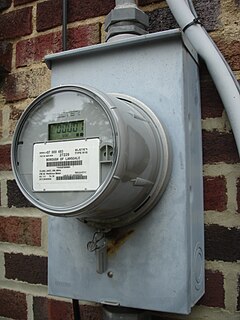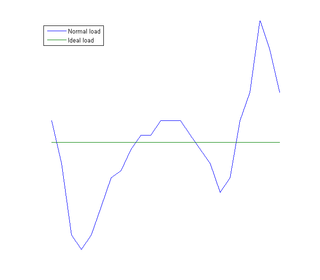
Automatic meter reading (AMR) is the technology of automatically collecting consumption, diagnostic, and status data from water meter or energy metering devices and transferring that data to a central database for billing, troubleshooting, and analyzing. This technology mainly saves utility providers the expense of periodic trips to each physical location to read a meter. Another advantage is that billing can be based on near real-time consumption rather than on estimates based on past or predicted consumption. This timely information coupled with analysis can help both utility providers and customers better control the use and production of electric energy, gas usage, or water consumption.

Water conservation includes all the policies, strategies and activities to sustainably manage the natural resource of fresh water, to protect the hydrosphere, and to meet the current and future human demand. Population, household size and growth and affluence all affect how much water is used. Factors such as climate change have increased pressures on natural water resources especially in manufacturing and agricultural irrigation. Many countries have already implemented policies aimed at water conservation, with much success.

Energy conservation is the effort made to reduce the consumption of energy by using less of an energy service. This can be achieved either by using energy more efficiently or by reducing the amount of service used. Energy conservation is a part of the concept of Eco-sufficiency. Energy conservation reduces the need for energy services and can result in increased environmental quality, national security, personal financial security and higher savings. It is at the top of the sustainable energy hierarchy. It also lowers energy costs by preventing future resource depletion.

Water heat recycling is the use of a heat exchanger to recover energy and reuse heat from drain water from various activities such as dish-washing, clothes washing and especially showers. The technology is used to reduce primary energy consumption for water heating.

Solar Cities is an innovative A$97 million demonstration programme designed to promote solar power, smart meters, energy conservation and new approaches to electricity pricing to provide a sustainable energy future in urban locations throughout Australia. Adelaide, Alice Springs, Blacktown, Central Victoria and Townsville were nominated to be the first Solar Cities of Australia, in the 2007 election campaign the Labor government committed to expanding the programme to include Coburg and Perth. Solar Cities is an innovative program that aims to show how technology, behavior change, and new approaches to energy pricing can combine to provide a sustainable energy future in urban locations throughout Australia".

Water supply and sanitation in South Africa is characterised by both achievements and challenges. After the end of Apartheid South Africa's newly elected government struggled with the then growing service and backlogs with respect to access to water supply and sanitation developed. The government thus made a strong commitment to high service standards and to high levels of investment subsidies to achieve those standards. Since then, the country has made some progress with regard to improving access to water supply: It reached universal access to an improved water source in urban areas, and in rural areas the share of those with access increased from 66% to 79% from 1990 to 2010.

Load management, also known as demand side management (DSM), is the process of balancing the supply of electricity on the network with the electrical load by adjusting or controlling the load rather than the power station output. This can be achieved by direct intervention of the utility in real time, by the use of frequency sensitive relays triggering the circuit breakers, by time clocks, or by using special tariffs to influence consumer behavior. Load management allows utilities to reduce demand for electricity during peak usage times, which can, in turn, reduce costs by eliminating the need for peaking power plants. In addition, some peaking power plants can take more than an hour to bring on-line which makes load management even more critical should a plant go off-line unexpectedly for example. Load management can also help reduce harmful emissions, since peaking plants or backup generators are often dirtier and less efficient than base load power plants. New load-management technologies are constantly under development — both by private industry and public entities.

The Steenbras Dam, now referred to as Steenbras Lower Dam, is a gravity concrete arch type dam located in the Hottentots-Holland mountains, above Gordons Bay, near Cape Town in South Africa. In 1916 a Board of Engineers was appointed to report on a water augmentation scheme for the city. Their proposal was the Steenbras scheme which would consist of a concrete gravity and arch dam on the Steenbras River. This dam would be connected to the Molteno reservoir through a tunnel in the Hottentots Holland mountains and a 64 kilometre long cast iron pipeline. Work began on the scheme in 1918 and was completed three years later. The Steenbras scheme could supply Cape Town with up to 42 million litres of water per day although the average consumption was in the region of 29 million litres per day. The consumption however grew rapidly and it was not long before Cape Town once again had a water supply problem. To solve the demand for additional water supplies the Steenbras dam wall was raised and an additional pipeline was laid into the city. This work was completed in 1928. For much of the first half of the twentieth century it was the main reservoir for Cape Town but is now only one of many dams that supply the city. The hazard potential of Steenbras has been ranked high (3).
Public water supply and sanitation in Denmark is characterized by universal access and generally good service quality. Some salient features of the sector in the Denmark compared to other developed countries are:

Water supply and sanitation in Senegal is characterized by a relatively high level of access compared to the average of Sub-Saharan Africa. One of the interesting features is a public-private partnership (PPP) that has been operating in Senegal since 1996, with Senegalaise des Eaux (SDE), a subsidiary of Saur International, as the private partner. It does not own the water system but manages it on a 10-year lease contract with the Senegalese government. Between 1996 and 2014, water sales doubled to 131 million cubic meters per year and the number of household connections increased by 165% to more than 638,000. According to the World Bank, "the Senegal case is regarded as a model of public-private partnership in sub-Saharan Africa". Another interesting feature is the existence of a national sanitation company in charge of sewerage, wastewater treatment and stormwater drainage, which has been modeled on the example of the national sanitation company of Tunisia and is unique in Sub-Saharan Africa.

A home energy monitor provides feedback on electrical energy use. Devices may also display cost of energy used, and estimates of greenhouse gas emissions. Various studies have shown a reduction in home energy use of 4-15% through use of home energy display.

Marine fuel management (MFM) is a multi-level approach to measuring, monitoring, and reporting fuel usage on a boat or ship, with the goals of reducing fuel usage, increasing operational efficiency, and improving fleet management oversight. MFM has grown in importance due to the rising costs of marine fuel and increased governmental stresses to reduce the pollution generated by the world's fleet.

The Western Cape Water Supply System (WCWSS) is a complex water supply system in the Western Cape region of South Africa, comprising an inter-linked system of six main dams, pipelines, tunnels and distribution networks, and a number of minor dams, some owned and operated by the Department of Water and Sanitation and some by the City of Cape Town.

Theewaterskloof Dam is an earth-fill type dam located on the Sonderend River near Villiersdorp, Western Cape, South Africa. Administratively it is located within Theewaterskloof Local Municipality. It was established in 1978 and is the largest dam in the Western Cape Water Supply System with a capacity of 480 million cubic metres, about 41% of the water storage capacity available to Cape Town, which has a population of over 4 million people. The dam mainly serves for municipal and industrial use as well as for irrigation purposes. The hazard potential of the dam has been ranked high (3).

Water supply and sanitation in Burkina Faso are characterized by high access to water supply in urban areas, while access to an at least basic water sources in rural areas – where three quarters of the population live – remains relatively low. An estimated one third of water facilities in rural areas are out of service because of a lack of maintenance. Access to at least basic sanitation lags significantly behind access to water supply.

Smart thermostats are thermostats that can be used with home automation and are responsible for controlling a home's heating and/or air conditioning. They perform similar functions as a Programmable thermostat as they allow the user to control the temperature of their home throughout the day using a schedule, but also contain additional features, such as sensors and WiFi connectivity, that improve upon the issues with programmable thermostats.
In Iran, like many other developed countries, Smart Grid implementation is regarded as a unique way for encountering many serious environmental and economic challenges that mankind is faced today. FAHAM is the National Smart Metering Program in Iran. The functional, technical, security, economic, and general requirements of this project was published as a document after a longtime workgroup of various stakeholders including representative of grid operators, meter manufactures, communication providers, business layer software providers, domestic and international consultants. The procedure of producing this document was base on EPRI Methodology. In these technical documents all of the business and functional use cases, the conceptual architecture, mandatory international standards for electric, water and gas metering systems(for all types of consumers),telecommunication requirements, system interfaces and security mandates are defined. The ministry of energy decided to perform a pilot project called FAHAM-phase1, in order to experiment the execution and technical challenges for implementing Smart Metering for all of the consumers.
Home idle load is the continuous residential electric energy consumption as measured by smart meters. It differs from standby power (loads) in that it includes energy consumption by devices that cycle on and off within the hourly period of standard smart meters. As such, home idle loads can be measured accurately by smart meters. According to Stanford Sustainable Systems Lab, home idle load constitutes an average of 32% of household electricity consumption in the U.S.














